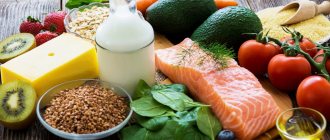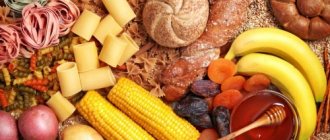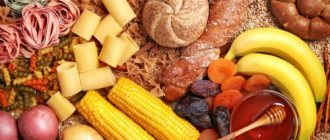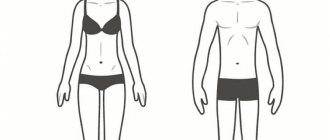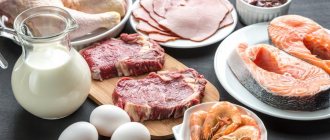A figure that is the envy of your friends, “seeing off” glances, a feeling of confidence and inner strength. Everything is achievable, just make a firm decision to change yourself. Give up bad habits, forget about weekends on the couch, train hard, no matter what. But most importantly, do not forget about the correct sports diet. It contains the key to a new active life.
Nutrition principles for gaining weight
An athletic figure implies beautiful, sculpted muscles. Simply losing weight is not the main goal in creating an attractive image. Therefore, in addition to focusing on burning fat, it is useful for girls to understand how muscle mass is built.
We do not recommend using diets. Yes, strict dietary restrictions will probably help you lose weight quickly. But you won’t be able to create a toned, athletic silhouette with a strict diet. In addition, you risk harming your health.
It is important to create a diet that will stimulate muscle growth, and not increase fat deposits. To do this, you must adhere to the fundamental principles:
- high calorie menu;
- the right combination of BZHU;
- fractional diet;
- calorie counting;
- taking sports supplements.
A few words about the myth widespread among women - “working with iron makes your figure masculine.” If you exercise without using steroid drugs, you don't need to worry about excessive muscle growth. The female body produces 7–10 times less testosterone than the male body. Therefore, you cannot spoil your figure even if you want to.
Caloric content of the diet
Nutrition to gain muscle mass should be high in calories. To find out how many calories you need to consume to gain muscle, first determine your basic daily requirement. To do this, use the following formulas.
Point 1 - initial calculation
Formula:
- Women from 18 to 30 years old: own weight in kg, multiply by 0.0621 and add 2.0357. Then multiply the resulting value by 240.
- Women from 31 to 60 years old: own weight in kg, multiply by 0.0342 and add 3.5377. Then multiply the resulting value by 240.
Point 2 - recalculation taking into account sports loads
Now you need to compare the number obtained in step 1 with the level of physical activity. If you don't play sports, leave everything as it is - you've found your basic daily requirement.
If you train 2-4 times a week, multiply the number obtained in step 1 by a factor of 1.3. If you do high-intensity exercise 4-5 times a week, multiply by 1.5.
Having determined the basic need, add another 200 kcal to it. The final number will be your individual daily requirement for gaining muscle mass.
Make a menu taking into account the obtained value and eat like this for a month. If your body weight stays the same or decreases by the end of 4 weeks, add another 100 kcal (from protein foods). Gradually increase your caloric intake until the weight goes up.
Calculation example
Task: calculate the calorie content of a mass-gaining menu for a girl (30 years old, weight 75 kg) who does strength training 3 times a week.
Solution:
- (75 x 0.0621 + 2.0357) x 240 = 1600 kcal;
- 1600 x 1.3 = 2080 kcal;
- 2080 + 200 = 2280 kcal.
Answer: daily caloric intake for muscle growth will be 2280 kcal.
The importance of a high-calorie diet is explained by physiology. If you reduce the calorie content of the menu (for example, in the hope of burning subcutaneous fat faster), the body will immediately respond to this by slowing down metabolic processes. The result will be a halt in progress in increasing muscle volume. Therefore, weight gain for girls must be accompanied by accurate calorie calculations.
Gainer at home
The basis of the drink should be natural products (milk, eggs, juices). Carbohydrate and protein components are added to them, for example, cottage cheese, honey, jam, oats. To prepare, you just need to mix the indicated ingredients in the required proportions and grind in a blender.
- Bananas (150 gr.), milk (350-400 ml), low-fat cottage cheese (100-150 gr.).
- Low-fat cottage cheese (150-200 gr.), raspberries (200 gr.), vanillin and cinnamon to taste.
- Low-fat cottage cheese (150-200 g), honey (2-3 tbsp), peanuts (50 g), bananas (2 pcs.), milk (150-200 ml).
- Milk (150-200 ml), milk powder (2 tbsp), sugar (1 tbsp), blueberry jam (2 tbsp).
- Classic yogurt (150 -200 ml), cocoa powder (2 tbsp), a small amount of walnuts or berries.
On days when there is no training, the gainer is taken between meals 1-2 times a day. On the day of the training, strictly after the training, this will be enough.
BZHU ratio during weight gain
We offer an example of calculating BJU for gaining muscle mass. But first, a little theory.
Firstly, 1 g protein = 4 kcal, 1 g fat = 9 kcal, 1 carbohydrate = 4 kcal.
Secondly, the BJU ratio for muscle growth is: 20%/30%/50%, respectively (the formula works for both men and women).
Let’s take an already familiar example: a 30-year-old girl, daily requirement is 2280 kcal. It is necessary to calculate the number of BZHU:
- Protein (20%): (2280 kcal x 20%)/100% = 456 kcal. Next, 456/4 = 114 g of protein per day (for example, 350 g of boiled chicken breast or 270–280 g of boiled pink salmon).
- Fat (30%): (2280 kcal x 30%)/100% = 684 kcal. Next 684/9 = 76 g of fat per day (for example, 80 g of olive or any other cold-pressed vegetable oil).
- Carbohydrates (50%): (2280 kcal x 50%)/100% = 1140 kcal. Next 1140/4 = 285 g of carbohydrates per day (for example, 1 kg of boiled buckwheat or 1 kg of boiled brown rice).
At first glance, it may seem that the volume of the diet is too large. But note that the products offered as examples are presented in already prepared form. Also, remember that all the food on your daily menu will be divided into 5-6 snacks. So don't be afraid. You will quickly get used to this amount of food and after a couple of weeks you will stop feeling any discomfort.
Carbohydrates
Carbohydrates provide the body with energy, stimulate digestive enzymes, facilitate the absorption of proteins and control the oxidation of fats in the body.
This group includes:
- various cereals;
- vegetables;
- fruits;
- pasta and flour products.
Carbohydrates are divided into simple (absorbed quickly) and complex (absorbed slowly). Simple ones include glucose and sucrose, which is found in sweets (waffles, honey, jam, cakes, etc.), flour products, juices, carbonated drinks, as well as rice and semolina flour.
Complex carbohydrates are represented by cereals, grains (this also includes muesli), and dried fruits.
If you just want to lose weight, then it will be enough to reduce the amount of simple carbohydrates you consume.
The video below provides clear information about a balanced diet.
We calculate the required number of BZHU:
- When gaining weight, proteins should be taken at the rate of 2-3 grams per kilogram of body weight. This amount must be evenly distributed over at least 5 meals a day.
- Carbohydrates are 4 grams per kilogram of your weight.
- Fats are present in an amount of 1 gram per kilogram of body weight.
Thus, an individual calculation of BJU for weight gain will look like this: amount of carbohydrates = amount of protein + amount of fat .
The scheme of this ratio is a basis that you can adjust and adjust to suit you during the process of gaining weight and subsequent drying.
If you are worried that you will incorrectly calculate the daily requirement, you can contact any fitness center or medical institution, where a professional trainer or nutritionist will analyze the physical condition of the body and adjust the nutrition program depending on the desired goal.
When gaining weight, meals are carried out 5-6 times a day, while in the first half of the day (before 16:00) you need to consume most of the diet.
A proper diet also helps create the glycemic index. It shows the effect of a certain food on blood sugar levels.
Foods with a low GI (less than 40) should be eaten more because they are slowly absorbed into the blood and can constantly maintain the energy level in the body at the required level.
These include:
- milk;
- legumes;
- nuts;
- pearl barley;
- pasta;
- zucchini;
- avocado;
- tomatoes.
Low GI foods are recommended to be consumed during a sedentary lifestyle, weight loss, or during periods of illness. Such products are good at reducing hunger, giving the body a long-lasting feeling of fullness, and preventing fat deposits, but they are ineffective during training.
Products with an average GI index (41-60) have an average rate of absorption and release.
These include:
- Rye bread;
- potato;
- beet;
- oatmeal;
- basmati rice;
- grape.
Products with a high GI (more than 60) include:
- sugar;
- melon;
- honey;
- candies;
- pancakes;
- bananas;
- flour products.
They are quickly absorbed into the blood and quickly release energy. It is because of frequent and sharp surges in sugar that fat deposits form on the human body.
Don't be afraid to add nutritional supplements to your regular diet. Study the features and purposes of each product and choose the one you need. We recommend starting with a gainer supplement containing the required amount of proteins and carbohydrates. It can be purchased ready-made or made at home from familiar products. The combination of products included in its composition promotes weight gain and weight gain.
Most often, ready-made gainer is sold in dry form and taken 1 scoop mixed with warm water, juice or skim milk. The preparation diagram and proportions are usually indicated on the packages.
Products for weight gain
You can get the required daily caloric intake from cakes, soda and hamburgers. But in this case, the quality of the gained mass will be extremely low (subcutaneous fat, water). In addition, eating fast food and cakes will negatively affect your well-being. Therefore, a mass-gaining diet should consist of healthy foods:
- Proteins : red meat, chicken, eggs, fish, caviar, shellfish, rabbit, cottage cheese (preferably homemade), legumes, cheese, nuts.
- Fats : vegetable oils (olive, sesame, flaxseed, corn, pumpkin, sunflower).
- Carbohydrates : premium pasta, buckwheat, brown rice, pearl barley, oatmeal, whole grain bread.
In addition to foods for gaining muscle mass, you need to include fiber in your diet. This substance is not broken down by digestive enzymes, but is processed by the microflora of the large intestine. Fiber helps maintain normal functioning of the gastrointestinal tract and remove toxins from the body. The daily fiber intake is 20–40 g (for example, 350–400 g of vegetables). Fiber can also be purchased separately in powder form and added to dishes.
Very often on women's forums you can come across the term “foods with negative calorie content.” It is believed that the body spends more energy on digesting such foods than it receives from them.
In fact, there are no products with such “properties” (the exception is pure water). It would be more correct to say “foods with minimal calorie content” (non-starchy vegetables, herbs, some fruits and berries).
Vitamin and mineral supplements
In addition to high-calorie nutrition for weight gain, you should include vitamin-mineral complexes for girls. Such supplements are involved in many processes in the body, including the formation of new muscle fibers. Let's look at the benefits of individual vitamins and minerals:
- AT 12 . Supports the normal functioning of the nervous system, participates in the metabolism of proteins, fats, carbohydrates, stimulates the growth of muscle cells, and increases endurance.
- IN 1 . Participates in metabolic processes, helps synthesize hemoglobin, promotes the rapid transfer of oxygen through cells, and prevents the onset of overtraining.
- AT 2 . Promotes the oxidation of fatty compounds, participates in the conversion of energy into muscle contractions, helps transport oxygen, and makes muscles elastic.
- Vitamins A and E. Participate in protein synthesis, ensure the formation of glycogen in muscles, protect ligaments and tendons, and restore damaged fibers.
- Vitamin C . Acts as a powerful antioxidant, improves oxygen absorption, protects connective tissue, stimulates the production of hormones, and participates in the synthesis of protein and collagen.
- Minerals needed by athletes: potassium - helps to recover faster after strength training, phosphorus and calcium - ensure strong bones and normal functioning of the musculoskeletal system, magnesium - stimulates the synthesis of essential amino acids, zinc - participates in the formation of muscle cells.
For girls, special vitamin and mineral complexes are produced that take into account female physiology. The best are Opti-Women from Optimum Nutrition, as well as Ultra Womens Multivitamin Formula from VPLab Nutrition.
Fractional power mode
Mass-building nutrition and training must be properly correlated. Be sure to eat 2 hours before class (carbohydrates and some protein). This will give you energy to perform strength exercises and protect muscle fibers from breakdown. Immediately after exercise, take a gainer or protein shake. When you get home, have a full dinner (protein and fiber).
All products on the menu must be divided into 5-6 servings. Carbohydrates should be spread over the first 4 snacks. Proteins and fats should be included in every meal. In the evening, instead of carbohydrate side dishes, prepare vegetable salads.
Don't skip snack time. If you're out and about, eat a protein bar.
Workout
Strength exercises
Strength exercises are your first and main way to build muscle. A typical strength training routine usually involves lifting weights (dumbbells, barbells, kettlebells, weight plates). Exercises like this help improve the endurance of your muscles, but also the growth of myofibers and mitochondria in the muscles. So when you sleep or rest, your muscles rebuild and rebuild—but this time, bigger and stronger. This process is called muscle fiber hypertrophy.
Use your body weight, TRX loops, resistance bands, or any other equipment to increase the physical challenge of your workout.
Table: approximate weight training program for girls
| Day | Target | Exercises |
| The first day | Legs and Buttocks | Leg press, barbell squats, dumbbell lunges, barbell alternating squats, kettlebell squats, single leg TPX squats, barbell hip raises, and walking lunges – 3 sets of 12 reps |
| Day Three | Chest and triceps | Push-ups, plank, side plank, dumbbell overhead press, dumbbell overhead press, incline dumbbell press, back bends, French press with resistance loops, triceps resistance loops, and chest push-ups - 3 sets of 12 reps each |
| Day Five | Upper back and shoulders | Dumbbell raises, barbell raises, waist presses, waist stretches, planks, cable face pulls, machine presses, barbell overhead presses, one-arm dumbbell rear and front raises - 4 sets of 7 reps each |
| Day Seven | Back and biceps | Close-grip barbell press, one-arm dumbbell raise, standing resistance loop stretch, bicep curls, dumbbell curls, barbell curls, plank and return to starting position, biceps curls - 3 sets of 12 reps each |
Remember, you need to vary your exercise routine to get better results.
Intense Interval Training
To maintain a leaner figure and give it more pronounced shape, you should add interval training to your routine, which includes fast and moving exercises for 30 seconds followed by 10 seconds of rest.
These short, high-intensity exercises work the fast-twitch muscle fibers that are needed to build muscle (endurance exercises or long exercises like running or walking only work the slow-twitch muscle fibers). Try introducing a few exercises into your routine:
Knee raises, squats, leg swings, squat jumps, lunge jumps, jump rope, rope exercise, leg raises, side lying, Russian twist, forward and backward leg throws, crunches and situps. Be sure to rest 60-90 seconds between exercises. Rest 10 seconds between sets.
Challenge yourself
Force yourself to study more, faster and harder. If you follow the same plan, don't expect progress.
The more you exercise, the more your muscles adapt to your exercises. As long as you don't add weight or difficulty to your workouts, your muscles will stay the same.
Tip: Exercise 3-5 days a week and do strength training on all other days to give your muscles time to rest.
But exercise is only one of the pillars of gaining muscle, and your diet is equally important.
Example of a daily diet
We offer a daily menu for gaining muscle mass for a girl (30 years old, weight 75, daily requirement 2280 kcal) who does strength training.
Breakfast:
- Oatmeal with water - 200 g (180 kcal).
- White of 5 boiled eggs (75 kcal).
- Sandwich (grain bread, butter, cheese) - 60 g (150 kcal).
- Orange - 1 pc. (40 kcal).
Snack:
- Cottage cheese (fat content 5%) - 200 g (180 kcal).
- Nut mixture - 50 g (240 kcal).
Dinner:
- Boiled brown rice - 150 g (170 kcal).
- Boiled chicken breast - 150 g (170 kcal).
- Vegetable salad (tomato, cucumber, vegetable oil) - 70 g (50 kcal).
- Red apple - 1 pc. (50 kcal).
Afternoon snack:
- Protein wafers - 200 g (400 kcal).
- Kefir (fat content 3.2%) - 150 ml (80 kcal).
Dinner:
- Baked pink salmon - 250 g (300 kcal).
- Vegetable salad (tomato, cucumber, vegetable oil) - 150 g (100 kcal).
Snack before bed:
- Casein protein in water - 200 ml (120 kcal).
The total calorie content of the presented diet is 2305 kcal.
You can’t eat the same menu every day. Foods need to be changed, for example, instead of chicken, cook rabbit or beef, instead of vegetable salad, cut a green salad, etc. The more varied the diet, the more nutrients the muscles will receive for growth and recovery.
Daily nutrition plan for women
There are thousands of meal plans you can make to fit your plan, but if you don't know where to start, here are some ideas. Of course, this is just a rough plan and you can change it as you wish.
Breakfast
- Oatmeal with peanut butter
- Fruit
- Some nuts as a source of protein
- Protein smoothie
Snack
Dinner
- Sandwich with chicken, cabbage and tomatoes
- Salad with tuna
- Fruits and vegetables
Snack before workout
- Nuts and seeds for energy and protein
- Dates or other dried fruits for carbohydrates (energy)
Dinner (after training)
- Brown rice fried with chicken or beef with vegetables
- Smoothie with milk and protein
- green leaves
Snack before bed
- Cottage cheese with fruit
Sports nutrition
We have already talked about the benefits of vitamin-mineral complexes. Let's take a look at other useful supplements for muscle growth:
- Protein. Used to replenish protein in the diet. Whey, egg, and beef proteins are considered to be of the highest quality in terms of their amino acid profile.
- Creatine. The supplement helps increase energy reserves. Thanks to this, the athlete can train a little longer. The recommended form of creatine is powder monohydrate.
- Gainer. Helps thin people gain weight. In addition to protein, it contains a portion of “fast” carbohydrates, vitamins, and minerals. Suitable for girls with an asthenic body type.
- BCAAs. A complex of essential amino acids - leucine, valine, isoleucine. The BCAA complex helps prevent catabolism (muscle breakdown) and is involved in the synthesis of new fibers.
- A simple amino acid complex. Contains a set of nonessential and essential amino acids. Helps maintain muscle mass, suitable as a snack;
- Protein bar. Contains proteins, fats, carbohydrates. Mainly used for a light snack when the athlete cannot eat a full meal.
Sports nutrition is not a steroid drug. You shouldn't expect rapid muscle growth from taking protein or creatine. These supplements help compensate for the deficiency of any elements and provide additional energy for strength exercises. Before use, we recommend consulting with an experienced fitness trainer.
How to eat to gain weight
For rational weight gain, you will need not only to exercise regularly, but also to eat right. To start gaining weight, you need not only muscle tissue, but also fat. To do this, you need a calorie surplus, that is, eat more food than you burn in a day. However, this does not mean that you need to eat everything, and especially lean on high-calorie foods. It is recommended to exclude fast food and soda from the diet, and add more animal protein to it: fish, meat. Complex carbohydrates are a must. You can also pay attention to sports nutrition: protein shakes help you gain weight faster and more easily transfer fat into muscles.

